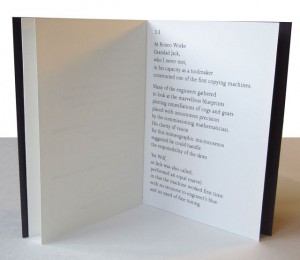
An Unknown Soldier (deluxe edition)
Henningham Family Press
2011
Edition of 30 (first 10 are in screenprinted oblique wooden box including 13 screenprints and two pamphlets)
Acquired by:
– Saison Poetry Library (Royal Festival Hall)
– University College London Library (special collections)
“Henningham’s mordant wit and avant-garde flair is part of another poetic tradition stretching back to Wyndham Lewis, Ezra Pound and the Dada pranksters of Zurich, although the first truly modernist treatment of the conflict in English emerged only in 1937 with the publication of David Jones’s In Parenthesis.” – David Collard, The Times Literary Supplement
Scientists have recently identified First World War casualties using saliva gleaned from the postage stamps on their letters home. Samples taken from their teeth, cross-referenced with a simple swab taken from living relatives, are also identifying soldiers’ remains. These events mean that DNA technology has unintentionally transformed the memorial to the Unknown Soldier in Westminster Abbey forever. This unidentified casualty was greeted by thousands of mourners in 1920, aware that he might be their loved-one, and that in his anonymity he stood for all of the lost. For these mourners he represented the hubris of industrial war, which has destructive power beyond our comprehension as the phrase ‘Known Unto God’ testifies. Yet now, thanks to DNA science, he can be known to us again, which means he is the only soldier we would deliberately refrain from identifying.
Does this mean that the Unknown Soldier has become a symbol for our failure to learn from the past? Do rituals of Remembrance actually enable us to forget? The million that marched through Westminster in 2003 to protest against the proposed Iraq War may well agree with that. Yet nobody is exempt from the difficulties and ironies that surround Remembrance. The politicians who lead us in Remembrance rites seem to be the first to forget. Often the rough sleepers who are shifted from the pavements before the parade takes place are, in fact, veterans. And there are people who cannot forget even if they want to, caring as they do for the wounded and missing their dead. These Unknown Soldiers continue to be a ‘regiment of warning’ stationed all around the world.
From the picking up of The Sun to the putting of it down again, we will remember them.
Military technology was not the only thing that caused the First World War to become so destructive. Such a vast body of men could not have been collected without advances in print technology and propaganda. In the light of this, Henningham Family Press created An Unknown Soldier in the form of printed poetry. Our generation only has third-hand knowledge of the First World War. The text of An Unknown Soldier includes many anecdotes passed down through the family, but many horrors were never put into words. There is a void at the heart of these stories like no-man’s land itself. Therefore the poem is interrupted by distorted letter forms that cut through the page like trenches in a battlefield. They allude to the dazzle camouflage created by Modernist artists like Edward Wadsworth. This was a war that artists of every stripe were a part of, from Kipling to Wyndham Lewis via the Artist Rifles. These screenprints shout dumbly from the wall. If only all propaganda were this difficult to read.
An Unknown Soldier is composed of three documents housed in an oblique wooden box. It begins with a book containing a screenprinted poem of instruction, Preparatory Oratory, which satirises official Remembrance with a voice like the bastard-child of BLAST and The Book of Common Prayer.
The second part is a screenprinted text of thirteen panels. This body of text is An Unknown Soldier himself. His dialect is from no-man’s-land, it is corrupted, the conjunctions decaying to leave the more solid vocabulary like disjointed bones. The lines of poetry never make it to the other side of the page, it is typeset like a body superimposed on a battlefield. The position of the stanzas on the wall reflects the human frame like a mirror. The poem has a head, a footnote and the phrase ‘Red Giant’ where his heart used to be. Yet the poem also resembles a network of trenches seen from the sky, and the soldier takes the reader on a walk through ‘The Capital’ at his belly, then to ‘The Nobiskrug’ in his stomach, which is the tavern on the road to hell. This is where he spent the ferryman’s wages. Then on to the ‘Semen’s Mission’, where we hear about a lost generation, and finally the ‘Labour Exchange’ where Miners exchanged pits for trenches for a period.
Part three, Funeral, March, is a triptych of verses that reflect on the author’s family on the home front and in peacetime, bound as a small Order of Service. It concludes with an affirmation of enduring hope in technology; the tale of Grandad Jack, a veteran, making a copying machine.







